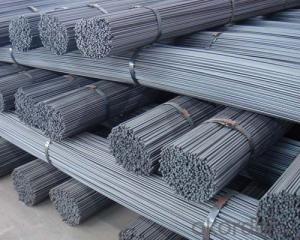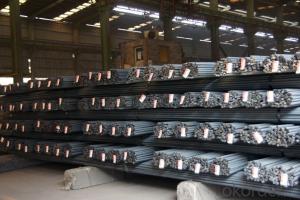HRB400 deformed bars with competitive price good quality
- Loading Port:
- Tianjin
- Payment Terms:
- TT OR LC
- Min Order Qty:
- 25 m.t.
- Supply Capability:
- 100000 m.t./month
OKorder Service Pledge
OKorder Financial Service
You Might Also Like
Product Description:
Specifications of HRB400 Deformed Steel Bar:
Standard | GB | HRB400 | |
Diameter | 10mm-32mm | ||
Length | 6M, 12M | ||
Place of origin | Hebei, China mainland | ||
Advantages | exact size, regular package, chemical and mechanical properties are stable. | ||
Type | Hot rolled deformed steel bar | ||
Chemical Composition: (Please kindly find our chemistry of our material based on HRB400 as below for your information)
Grade | Technical data of the original chemical composition (%) | ||||||
C | Mn | Si | S | P | V | ||
HRB400 | ≤0.25 | ≤1.60 | ≤0.80 | ≤0.045 | ≤0.045 | 0.04-0.12 | |
Physical capability | |||||||
Yield Strength (N/cm²) | Tensile Strength (N/cm²) | Elongation (%) | |||||
≥400 | ≥570 | ≥14 | |||||
Theoretical weight and section area of each diameter as below for your information:
Diameter(mm) | Section area (mm²) | Mass(kg/m) | Weight of 12m bar(kg) |
18 | 254.5 | 2.00 | 24 |
20 | 314.2 | 2.47 | 29.64 |
22 | 380.1 | 2.98 | 35.76 |
Usage and Applications of HRB400 Deformed Steel Bar:
Deformed bar is widely used in buildings, bridges, roads and other engineering construction. Big to highways, railways, bridges, culverts, tunnels, public facilities such as flood control, dam, small to housing construction, beam, column, wall and the foundation of the plate, deformed bar is an integral structure material. With the development of world economy and the vigorous development of infrastructure construction, real estate, the demand for deformed bar will be larger and larger..
Packaging & Delivery of HRB400 Deformed Steel Bar:
Packaging Detail: products are packed in bundle and then shipped by container or bulk vessel, deformed bar is usually naked strapping delivery, when storing, please pay attention to moisture proof. The performance of rust will produce adverse effect.
Each bundle weight: 2-3MT, or as required
Payment term: TT or L/C
Delivery Detail: within 45 days after received advanced payment or LC.
Label: to be specified by customer, generally, each bundle has 1-2 labels
Trade terms: FOB, CFR, CIF
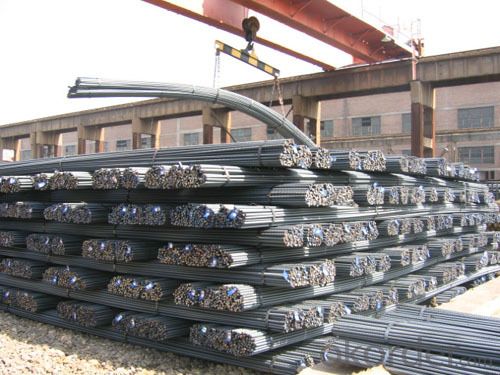
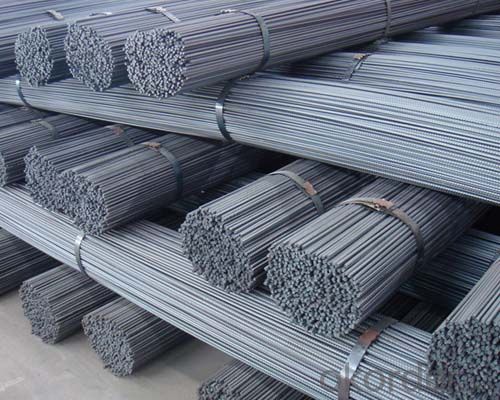
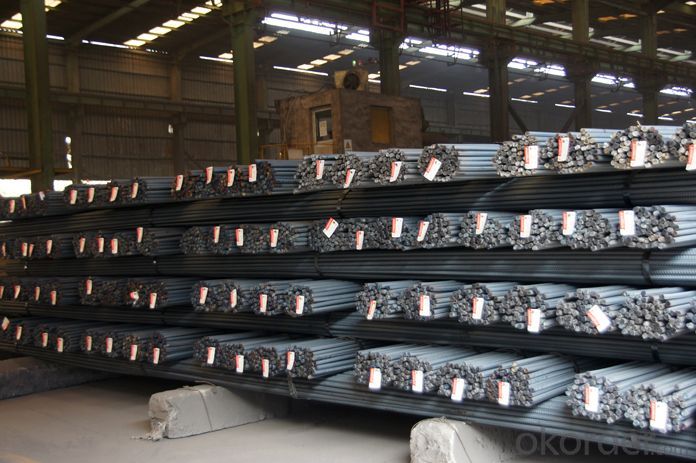
*If you would like to get our price, please inform us the size, standard/material and quantity. Thank you very much for your attention.
- Q:Can steel rebars be used in the construction of water treatment plants?
- Yes, steel rebars can be used in the construction of water treatment plants. Steel rebars are commonly used in the construction industry to reinforce concrete structures, and water treatment plants often require robust and durable infrastructure. Steel rebars provide strength and stability to the concrete components, making them suitable for use in the construction of water treatment plants.
- Q:What is the maximum length of steel rebars available?
- The maximum length of steel rebars available varies depending on the specific manufacturer and supplier. However, in general, steel rebars are commonly available in lengths ranging from 6 meters (20 feet) to 18 meters (60 feet). These lengths are determined by factors such as transportation logistics, handling capabilities, and construction industry standards. It is important to consult with the manufacturer or supplier to determine the specific maximum length of steel rebars they offer.
- Q:What are the guidelines for the proper spacing of steel rebars in columns?
- The guidelines for the proper spacing of steel rebars in columns are provided by various national and international codes and standards, such as the American Concrete Institute (ACI) and the British Standards Institution (BSI). These guidelines ensure the structural integrity and durability of the reinforced concrete columns. The spacing of steel rebars in columns is primarily determined by the following factors: 1. Concrete cover: The minimum concrete cover is specified by the codes to protect the steel reinforcement from corrosion and provide fire resistance. The spacing between rebars should be such that the required concrete cover is maintained uniformly around each rebar. 2. Rebar diameter: The size or diameter of the rebars influences their spacing. The codes specify the minimum clear spacing between adjacent rebars based on their diameter to prevent congestion and ensure proper concrete placement. 3. Column dimension: The size and shape of the column also play a significant role in determining the rebar spacing. Larger columns may require additional rebars compared to smaller ones to provide adequate reinforcement and resist the applied loads. 4. Load and design requirements: The design loads, including dead loads, live loads, and seismic loads, impact the spacing of rebars. The codes provide guidelines on the minimum amount of reinforcement required based on the column's dimensions and the anticipated loads. 5. Structural detailing: Proper detailing is essential to ensure the rebars are adequately anchored and lapped to develop the required bond strength. Guidelines for lapping lengths, anchorage lengths, and splices are provided in the codes to ensure the transfer of forces between the rebars and concrete. It is crucial to consult the specific code or standard applicable in your region to determine the exact guidelines for the spacing of steel rebars in columns. Additionally, it is recommended to engage a qualified structural engineer or designer to perform detailed analysis and design of reinforced concrete columns to ensure compliance with the appropriate guidelines and achieve a safe and efficient structural system.
- Q:Are steel rebars suitable for use in tunnels and underground mines?
- Tunnels and underground mines can benefit greatly from the use of steel rebars. These reinforcement bars, also called steel rebars, are commonly utilized in construction due to their strength and durability. In environments where structural integrity is crucial, such as tunnels and underground mines, steel rebars offer the necessary reinforcement to withstand the heavy loads and pressures associated with these settings. Steel rebars possess exceptional tensile strength, enabling them to resist bending and cracking even under high stress. This attribute is particularly important in tunnels and underground mines, where the surrounding rock and soil exert significant pressure on the structure. By reinforcing the concrete or other structural materials with steel rebars, the overall strength and stability of the tunnel or mine are enhanced, mitigating the risk of collapse or damage. Moreover, steel rebars exhibit resistance to corrosion, rendering them suitable for use in underground environments where moisture and chemical exposure are prevalent. Corrosion can weaken reinforcement materials, compromising the safety of the tunnel or mine. Conversely, steel rebars provide long-lasting reinforcement, ensuring the infrastructure's longevity and reliability. Additionally, steel rebars offer convenience in fabrication and installation, making them a practical choice for tunnel and underground mine construction. They can be easily cut and bent into specific shapes and sizes, facilitating customized reinforcement solutions tailored to the unique requirements of each project. This versatility and ease of installation make steel rebars an advantageous option for tunnels and underground mines, which often encounter complex geometries and challenging conditions. In conclusion, steel rebars are an ideal choice for tunnels and underground mines due to their strength, durability, corrosion resistance, and ease of installation. By utilizing steel rebars as reinforcement, these structures can be built to withstand demanding conditions, ensuring the safety of workers and the long-term viability of the infrastructure.
- Q:Are steel rebars resistant to lightning strikes?
- No, steel rebars are not inherently resistant to lightning strikes.
- Q:What's the difference between round bar and screw steel? Which one is cheaper on the market at present?
- Round bar is divided into three parts: hot rolling, forging and cold drawing. Standard Specification for hot rolled round steel is 5.5-250 mm. Of which: 5.5-25 mm of small round bars, commonly used as steel, bolts and various mechanical parts, larger than 25 millimeters of round steel, mainly for the manufacture of machinery parts. Round steel has many kinds of materials, such as: Q195, Q235, 10#, 20#, 35#, 45#, Q215, Q235, 304, 316, 20Cr, 40Cr, 20CrMo, 35CrMo, 20CrMnTi, 5CrMnMo, etc...
- Q:Two grade steel and three grade steel difference, the construction of the use of thread steel in general how to use the level?
- The corresponding plasticity is a little worse. In the past, most of the rebar on the site was made of two grade steel. In the past few years, the country adjusted the standard brick, and gradually used three or even four steel. Two grade steel has been gradually withdrawn from the market, many large steel mills have not been produced
- Q:How do steel rebars perform in extreme temperature conditions?
- Steel rebars perform well in extreme temperature conditions due to their high thermal conductivity and low coefficient of thermal expansion. This means that they can efficiently transfer heat and resist deformation caused by temperature changes. In extremely high temperatures, steel rebars retain their strength and structural integrity. They have a high melting point and maintain their properties even in intense fire situations. This makes them ideal for reinforcing structures such as buildings, bridges, and tunnels, where fire resistance is crucial. In extremely low temperatures, steel rebars also perform admirably. Unlike some other materials, steel does not become brittle and lose its strength in cold conditions. This makes it suitable for use in cold climates and regions with frequent freeze-thaw cycles. Furthermore, steel rebars have excellent durability and can withstand extreme temperature fluctuations without significant degradation. They do not expand or contract excessively, which helps to maintain the stability and longevity of reinforced structures. However, it's important to note that extreme temperatures can still have some impact on steel rebars. In very high temperatures, steel may experience some thermal expansion, which can cause minor stresses in the surrounding concrete. Similarly, in very low temperatures, some contraction may occur, but these effects are usually minimal and well within acceptable limits. Overall, steel rebars are a reliable choice for reinforcing structures in extreme temperature conditions, as they offer excellent strength, durability, and fire resistance.
- Q:Are there any limitations on the length of steel rebars?
- Yes, there are limitations on the length of steel rebars. The maximum length of steel rebars is typically determined by transportation and handling constraints. Longer rebars may become difficult to transport and maneuver, posing safety risks. Additionally, longer rebars may be more prone to bending or deformation during installation, compromising their structural integrity. Therefore, industry standards and regulations typically specify maximum lengths for steel rebars to ensure safe and efficient construction practices.
- Q:Can steel rebars be used in underground structures?
- Yes, steel rebars can be used in underground structures. Steel rebars are commonly used in construction, including underground structures such as tunnels, basements, and foundations. The high strength and durability of steel rebars make them suitable for reinforcing concrete structures in underground environments, providing enhanced structural integrity and ensuring long-term stability and safety.
1. Manufacturer Overview |
|
|---|---|
| Location | |
| Year Established | |
| Annual Output Value | |
| Main Markets | |
| Company Certifications | |
2. Manufacturer Certificates |
|
|---|---|
| a) Certification Name | |
| Range | |
| Reference | |
| Validity Period | |
3. Manufacturer Capability |
|
|---|---|
| a)Trade Capacity | |
| Nearest Port | |
| Export Percentage | |
| No.of Employees in Trade Department | |
| Language Spoken: | |
| b)Factory Information | |
| Factory Size: | |
| No. of Production Lines | |
| Contract Manufacturing | |
| Product Price Range | |
Send your message to us
HRB400 deformed bars with competitive price good quality
- Loading Port:
- Tianjin
- Payment Terms:
- TT OR LC
- Min Order Qty:
- 25 m.t.
- Supply Capability:
- 100000 m.t./month
OKorder Service Pledge
OKorder Financial Service
Similar products
New products
Hot products
Related keywords

